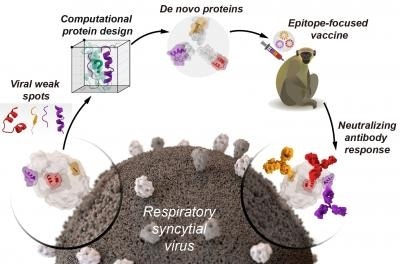Vaccines are regarded as one of the most effective interventions to stop the spread of infectious diseases. They produce antibodies by activating the immune system. These antibodies, in turn, protect humans from infections.

EPFL scientists have developed a new computational approach to create artificial proteins, which showed promising results in vivo as functional vaccines. This approach opens the possibility to engineer safer and more effective vaccines. Image Credit: EPFL.
In spite of this fact, there is still a dearth of efficacious vaccines for several significant pathogens, such as dengue fever or flu.
When a vaccine doesn’t work well, we tend to think that it's because the antibodies produced are not protective. It’s usually because our immune system is simply making the wrong type of antibodies.”
Bruno Correia, Professor, Laboratory of Protein Design & Immunoengineering, School of Engineering, EPFL
Researchers working in Correia’s lab have recently developed an approach to design artificial proteins that accurately instruct the body’s immune system to produce the required types of antibodies. The study has been published in the Science journal.
Building proteins like Legos
The EPFL research team developed artificial proteins using computational techniques. According to Yang, a Ph.D. student, and the study’s co-leading author, “They don’t exist in nature.”
We developed a protein design algorithm called TopoBuilder. It lets you construct proteins virtually as if you were putting Lego bricks together. Assembling artificial proteins that have novel functions is absolutely fascinating.”
Fabian Sesterhenn, Study Co-Leading Author and PhD Student, EPFL
A disease without a vaccine
Correia and his team studied the design of the de novo proteins that can lead to the development of a vaccine for the respiratory syncytial virus (RSV). RSV accounts for severe lung infections and is a major cause of hospitalization of the elderly and infants.
Correia added, “Despite several decades of research, up to today there is still no vaccine or cure for the respiratory syncytial virus.”
The researchers created the artificial proteins in the laboratory, tested in animal models, and then activated the immune system to create the particular antibodies against weak spots in RSV.
Our findings are encouraging because they indicate that one day we will be able to design vaccines that target specific viruses more effectively, by prompting the immune system to generate those particular antibodies. We still have a lot of work ahead to make the vaccine we developed more effective—this study is a first step in that direction.”
Bruno Correia, Professor, Protein Design & Immunoengineering Laboratory, EPFL School of Engineering
Techniques for producing de novo proteins have applications not only in the field of immunology but also in various branches of biotechnology to extend the functional and structural range of natural proteins.
“We can now use the protein design tools to create proteins for other biomedical applications such as protein-based drugs or functionalized biomaterials,” Sesterhenn concluded.